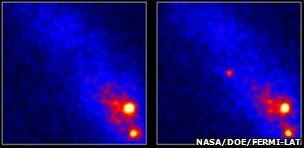Gamma rays from nova explosion surprise astronomers
- Published

A team of astronomers has found that novae - the relatively quiet death of certain kinds of stars - can emit the highest-energy rays known to nature.
It was not previously thought that novae, which come about for different reasons than the brighter supernovae, could give rise to these gamma rays.
Users of the Fermi space telescope have now confirmed these observations, which were first made by amateur astronomers.
The find runs counter to existing theories of how stars evolve and die.
It was published in the journal Science.
Novae are the lesser of two bright shows marking the end of a star's life. Large stars end in the more spectacular explosions known as supernovae, which generate fast-moving particles in extraordinarily high magnetic fields. When these particles collide with other matter, gamma rays can result.
Amateur find
Most stars do not have enough mass to start the chain of events that leads to a supernova.
Instead they contract to become white dwarfs. Those white dwarf stars that find themselves near a "companion" star can draw material from their neighbour, building up to a critical mass and eventually sparking nuclear fusion again in a nova.
However, theory has held that such novae do not involve such cataclysmic processes that give rise to gamma rays.
Now, an international team of astronomers has trained the Fermi space-based gamma ray telescope on V407 Cygni, a "binary" system comprising a white dwarf star and a red giant companion, 9,000 light-years away.
They had been alerted to the system by amateur Japanese astronomers who had spotted that V407 Cygni had increased in brightness by 10 times over just a few days.
The Fermi telescope is specially designed to capture gamma rays, and the team was surprised to find that it was spitting out gamma rays at completely unexpected energies.
The nova is providing a unique stellar laboratory, shedding light on processes normally confined to supernovae that are too slow for Earth-bound astronomers to learn from quickly.
"It takes thousands of years for supernova remnants to evolve, but with this nova we've watched the same kinds of changes over just a few days," said Kent Wood, a co-author on the Science study from the Naval Research Laboratory in Washington, DC.
"We've gone from a photo album to a time-lapse movie."
What is a light year? Dr Tim O'Brien from Jodrell Bank explains